Effect of Inventory Software on Employee Theft Prevention
The National Retail Federation estimates that employee theft accounts for approximately 44 percent of all inventory shrinkage for retailers in the United States—amounting to $15 billion annually. Retail management is hard enough without worrying about employee theft.
To help retail owners and managers better understand and control employee theft, we surveyed a random sample of U.S. retail employees on how inventory management technology can aid employee theft prevention.
Key Findings
Twenty-eight percent of employees whose stores use inventory management software say internal theft is a problem, compared to 37 percent of those whose stores use other methods for managing inventory.
Fifteen percent of employees whose stores use inventory management software admit to stealing from their store, versus 22 percent of employees whose stores use other methods.
Only 37 percent of small “mom and pop” stores are using inventory management software, versus 53 percent of local and regional retail chains and 85 percent of national retail chains surveyed.
Introduction
Addressing the problem of employee theft can be difficult. No employer wants to find out that an employee has betrayed his or her trust; similarly, no employee wants to feel as if he or she is being unfairly targeted by management for suspected theft.
Traditional retail POS systems often offer inventory management features, but few include theft protection. Technological solutions for employee theft prevention, such as security cameras and magnetic tags, can do a great job of uncovering theft either during or after it occurs.
However, they can also be easily foiled: Security cameras have blind spots and are only effective when the footage is actively monitored, while employees can readily access the devices used to safely remove magnetic tags.
This is where software can be beneficial.
“A software solution to employee theft is important for several reasons,” says Jeff Hindman, vice president of NCR Corporation. (NCR develops software and hardware solutions for transaction-based businesses, such as retailers and restaurants.)
“First, the most common scams would be impossible to catch consistently with other available monitoring methods. Second, software is not only more effective at identifying suspicious behavior, it is also ‘always on,’ and improves on inconsistent detection methods like management spot-checks to monitor employee behavior, [which] can easily miss theft,” he explains.
Modern inventory management systems can also play a role in theft deterrence by integrating with other software and hardware that can detect suspicious patterns when inventory goes missing.
To learn more about the connection between usage of specialized inventory management software and lower rates of employee theft, we turned to our survey respondents.
Lower Internal Theft Linked to Inventory Software Usage
We first asked respondents what system(s) their store uses to manage inventory, allowing them to choose from a list of options: specialized inventory management software, general office productivity software (e.g., Word or Excel), accounting software (e.g., QuickBooks) or pen and paper.
Then, we asked about their perceptions of employee theft—and if they had ever stolen from their employer themselves. With this data, we were able to identify several interesting correlations.
A combined 28 percent of retail employees whose stores use inventory management software report employee theft as a “moderate” or “significant problem.” Conversely, 37 percent of employees whose stores use other methods for inventory management say the same.
In fact, just 8 percent of employees whose stores use inventory software report employee theft as “significant.” As the use of this technology can help increase visibility and improve the accuracy of cycle counts, it may be easier for managers using this method to notice any discrepancies.
Employee Perceptions of Theft
by Inventory Management Method
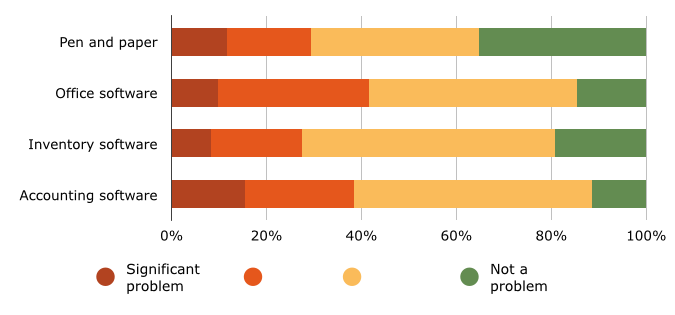
Interestingly, a significant number of employees whose stores use pen and paper for inventory management report that employee theft is “minimal” or “not a problem” at all, with 71 percent saying so—just behind the 72 percent of employees from stores using inventory software who say the same. (More on this in the next section.)
Lower Admission of Theft Linked to Inventory Software Usage
Employees whose stores use inventory management software also admit stealing from their store (on at least one occasion) at lower frequencies than employees whose stores utilize other methods for inventory management: 15 percent versus 22 percent, respectively.
And stores using accounting software for inventory management purposes have the highest percentage of employees who admit to stealing (35 percent).
Looking at perceptions of employee theft plotted against admissions of theft, we see that the more likely employees are to report internal theft as a problem, the more likely they are to have stolen from their store.
While this may not be surprising, it does suggest a high degree of internal validity to our findings: Respondents’ answers to our questions were consistent with each other.
Employee Admissions of Theft, by Inventory Management Method
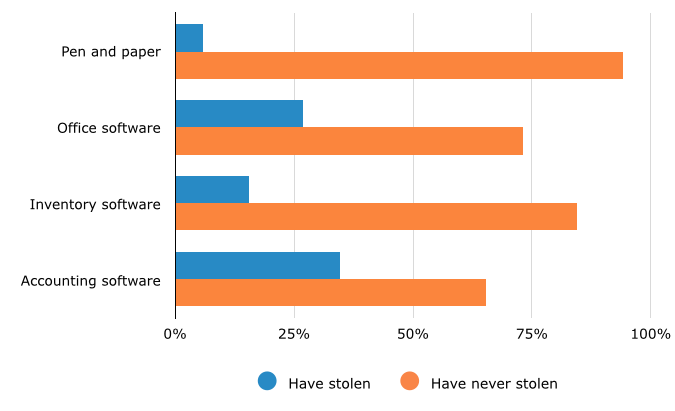
Employee Perceptions vs. Admissions of Theft
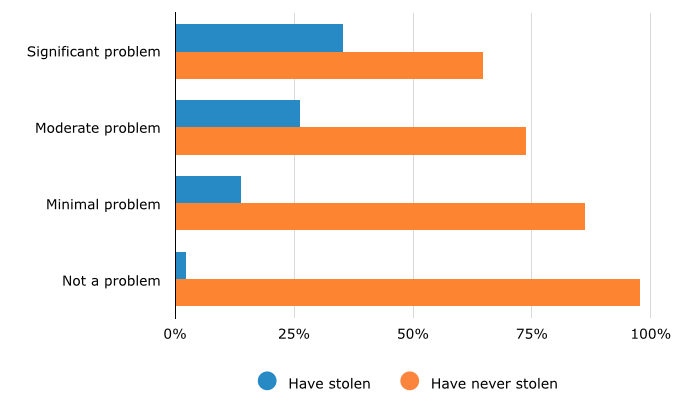
As we noted above, it is interesting that perceptions of employee theft as a problem are significantly lower among employees whose stores use pen and paper methods for inventory management. Similarly, only 6 percent of these same employees admit to stealing themselves—a lower percentage than any other method.
But why is this? One possible explanation is the types of stores in which these methods are being used.
Theft a Polarized Problem at ‘Mom and Pop’ Shops
Pen and paper methods are more widely used by small, “mom and pop” stores—in fact, of all the stores in our survey using pen and paper methods, over half fall into this category.
We also find that 38 percent of retail employees working at “mom and pop” stores report employee theft as being “not a problem,” compared to just 17 percent of employees working at local/regional chains and 18 percent of employees working at of national, “big box” stores.
At the same time, “mom and pop” stores have the highest percentage of employees that say internal theft is a “moderate” or “significant” problem. So, there is a bit of polarization at play here.
This is likely due to the fact that for small businesses, employee theft may be less common, but its impact is more damaging—smaller stores tend to have much smaller inventories and/or a tighter cash flow, which can make theft more noticeable.
While the problem is likely more pervasive in bigger firms, it’s less serious, as costs are more easily absorbed.
Employee Perceptions of Theft, by Store Type
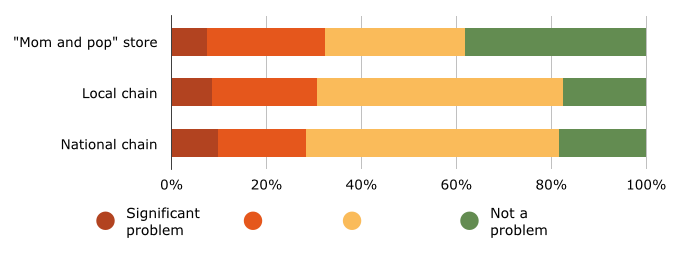
Interestingly, research from the Association of Certified Fraud Examiners (ACFE) notes that small businesses actually report cases of internal theft and fraud at a higher rate than larger businesses. This could simply mean, however, that these cases are more evident in smaller organizations, whereas they are more likely to go unnoticed in larger organizations.
That same report from the ACFE notes that cash theft and payroll or check tampering are more prevalent in smaller firms, while non-cash theft or fraud is more prevalent in larger firms. This makes sense: Shrinkage isn’t as big a deal to larger firms that can recoup the losses, and it’s much harder to steal cash in those firms.
At smaller firms, however, the more common crimes of cash theft or accounting fraud can be far more devastating, due to these stores’ tighter profit margins.
So how can inventory management software help with all this? First, it’s an issue of accuracy and visibility. Using software allows retailers to perform more accurate cycle counts, as they avoid having to manually update inventory levels from their point-of-sale (POS) platform.
What’s more, theft deterrence technology that integrates with inventory management software is vital for preventing shrinkage.
According to the International Foundation for Protection Officers, one common problem retailers face is when employees conduct fraudulent transactions in order to pull cash from the register, or when they give customers a “discount” at the checkout counter by ringing up an expensive item as a less expensive item.
If there is suspicious activity, inventory management software can alert the user to perform a cycle count of inventory to determine whether a legitimate transaction occurred.
A stalwart of in-store security, video surveillance was once dependent on someone monitoring footage continuously, or reviewing footage from when a theft allegedly occurred.
But with software, video surveillance can now detect a lot more than just what meets the eye. Video analytics, an emergent technology, can tell a side of a story that the owner can’t see on tape even if he or she watches it.
For example, a camera placed above the register can be synced with certain inventory management and POS systems. Every time a transaction is processed, the video analytics software can detect if there is, in fact, a paying customer on the other side of the counter, and if the items that are being rung up are actually what is being purchased.
This kind of technology can help even smaller, short-staffed stores better mitigate employee theft.
‘Mom and Pop’ Shops Least Likely to Use Software
Despite these benefits, according to our respondents, only 37 percent of the “mom and pop” stores in our sample use inventory management software, compared to 53 percent of local or regional chains and 86 percent of national “big box” stores in our sample.
Inventory Management Methods, by Retailer Type
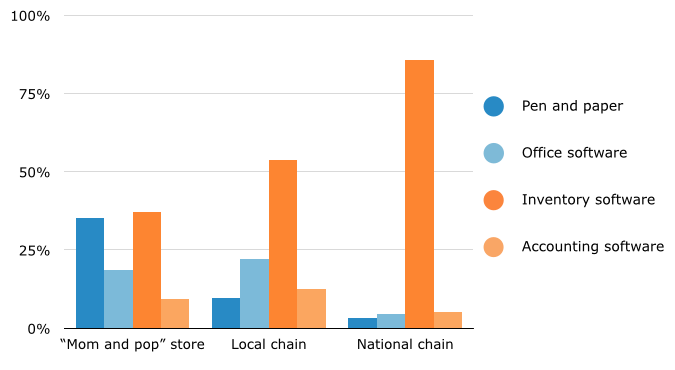
Fewer “mom and pop” shops might be using specialized inventory management software for several reasons. First, they might have a low volume of sales, or a smaller inventory of products, which makes managing inventory with non-specialized methods more feasible.
Second, the software could be cost-prohibitive. While there has been an explosion in software vendors offering cheaper, subscription-based inventory management systems in recent years, they can still cost hundreds or thousands of dollars a year.
Finally, small retail store owners might simply be unaware that these software-based inventory solutions exist. This presents many marketing opportunities for inventory management software vendors who specifically target small to midsize businesses.
For example, NCR’s Aloha Restaurant Guard is a theft deterrence program that is able to identify common scams committed by restaurant employees when they use their POS system.
According to Hindman, one of these scams occurs when a customer pays in cash and the server uses the check-splitting functionality on the POS system to remove items from a customer’s ticket, thus allowing them to pocket the difference.
Aloha is able to sort through thousands of transactions to identify these suspicious patterns—something managers or owners can’t effectively do by themselves.
Larger businesses have a leg up in deploying the most modern and advanced solutions. For example, radio frequency identification (RFID) tags have become incredibly popular among large retailers. RFID tags emit signals that can be detected by a hand-held scanner, transmitting item-specific information such as type, size, color and so on.
These tags make inventory cycle counting much easier, as users can simply walk by the items with a scanner in hand, instead of manually scanning each item like they would with a traditional barcode system.
Software systems can integrate with this technology to help detect patterns in theft, Hindman says. For example, if a clothing retailer notices that size eight women’s shoes frequently go missing at specific times—evidenced by the information culled from the RFID tags—this can help identify who the culprit might be, if it is an employee.
Demographics
In all, 48 percent of our respondents say they work at national, “big-box” retailers. Thirty-four percent say they work for local or regional chain retailers, and 18 percent say they work for small, “mom and pop” stores.
Respondents by Store Type
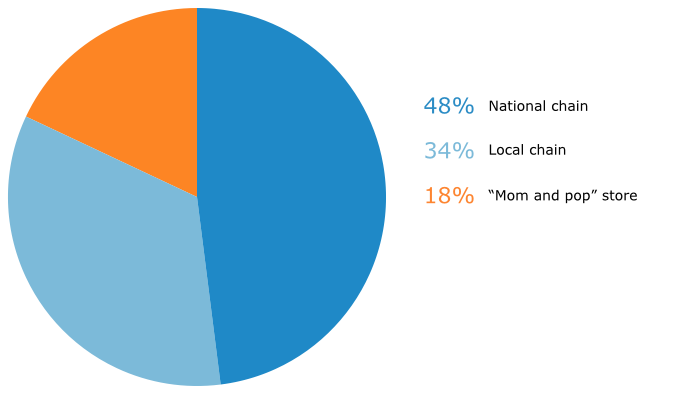
More than two-thirds of respondents identify as being entry-level sales associates, cashiers and so on. Managers constitute 28 percent of our sample, while a small number of store directors and regional directors also participated in the survey.
Respondents by Job Title
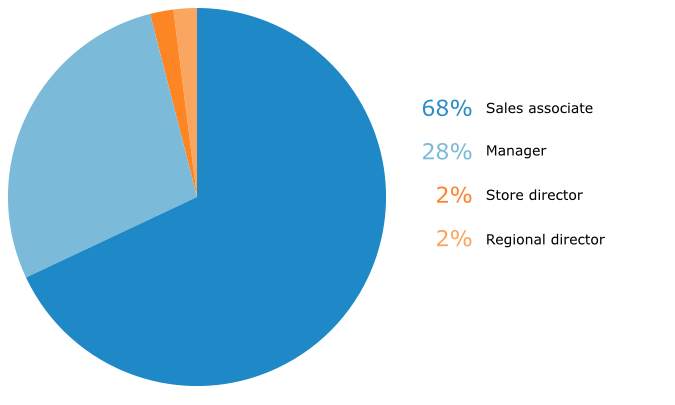
Conclusions
While technological solutions to prevent employee theft abound, it is important that they do not interfere with storefront operations, says Kim Warne, director of marketing at Tyco Retail Solutions. Tyco is an industry leader in theft deterrence technology for retailers.
“Retailers don’t want an over-engineered solution,” says Warne, adding that “loss prevention and security need to occur in the background” so as not to diminish the customer experience—or make employees’ jobs harder.
Still, Warne notes that technological approaches to preventing employee theft work best when there is mutual respect between employees and their employers, and that employers still have to address the root problem of deterring employees from committing theft in the first place.
“If you care about your employees, they’ll care about your store,” says Warne, noting that lower turnover rates—typically a good measure of employee satisfaction—often correlate with lower incidences of employee theft.
Hindman, of NCR, also says that the human element is critical for effective theft deterrence.
“Software monitoring should enhance, not replace, management’s efforts around employee theft,” he explains.
“The most effective implementation is typically where software is used to efficiently identify where management involvement is needed, provide the appropriate data for managers to make decisions and allow operators to be well-informed when working directly with an employee.”
Methodology
To find the data in this report, we conducted a seven-day online survey of six questions, and gathered 385 responses from random retail employees within the United States. All survey questionnaires undergo an internal peer review process to ensure clarity in wording.
Sources attributed and products referenced in this article may or may not represent partner vendors of Software Advice, but vendor status is never used as a basis for selection. Interview sources are chosen for their expertise on the subject matter, and software choices are selected based on popularity and relevance.
Expert commentary solely represents the views of the individual. Chart values are rounded to the nearest whole number.
If you have comments or would like to obtain access to any of the charts above, please contact forrest@softwareadvice.com.